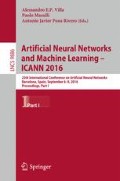Abstract
Striatal medium spiny neurons (MSNs) constitute input nuclei of the basal ganglia. Most well-known dichotomous of striatal MSNs stem from dopaminergic modulation of striatal processing. Dopamine modulates excitability in striatal MSNs with a complex underlying mechanism and lack of balance in this delicate system leads to pathologies such as Parkinson’s disease. On the contrary, investigation of such a system requires simple, but yet comprehensive models that are capable of capturing complex behaviour of MSNs. We propose a reduced-computational but biologically plausible model that mimics the cell dynamics of striatal D\(_1\)- and D\(_2\)-type MSNs with different levels of dopamine using data from a recent study. Proposed computational model shows good matches to the MSN responses and captures some essential features of MSNs such as first spike latencies, dopamine modulated state transitions and enhanced response to depolarizing input during dopamine intervention.
Access this chapter
Tax calculation will be finalised at checkout
Purchases are for personal use only
References
Cools, R., Ivry, R.B., D’Esposito, M.: The human striatum is necessary for responding to changes in stimulus relevance. J. Cogn. Neurosci. 18, 1973–1983 (2006)
Gillies, A., Arbuthnott, G.W.: Computational models of the basal ganglia. Mov. Disord. 15, 762–770 (2000)
Nieoullon, A.: Dopamine and the regulation of cognition and attention. Neurobiology 67, 53–83 (2002)
Apicella, P., et al.: Neuronal activity in monkey striatum related to the expectation of predictable environmental events. J. Neurophysiol. 68, 945–960 (1992)
Gerfen, C.R.: Molecular effects of dopamine on striatal projection pathways. Trends Neurosci. 23, 64–70 (2000)
Keshavan, M.S., et al.: Psychosis proneness and ADHD in young relatives of schizophrenia patients. Schizophr. Res. 59, 85–92 (2003)
Weiner, I., Joel, D.: Dopamine in schizophrenia: dysfunctional processing in basal ganglia-thalamocortical split circuits. In: Handbook of Experimental Pharmacology: Dopamine in the CNS, vol. 154, pp. 417–471 (2002)
Humphries, M.D., et al.: Capturing dopaminergic modulation and bimodal membrane behaviour of striatal medium spiny neurons in accurate, reduced models. Front. Comput. Neurosci 3, e1001011 (2009)
Moyer, J.T., Wolf, J.A., Finkel, L.H.: Effects of dopaminergic modulation on the integrative properties of the ventral striatal medium spiny neuron. J. Neurophysiol. 98, 3731–3748 (2007)
Gruber, A.J., Solla, S.A., Houk, J.C.: Dopamine induced bistability enhances signal processing in spiny neurons. In: Advances in Neural Information Processing Systems, vol. 15, pp. 165–172. MIT Press, Cambridge (2003)
Guthrie, M., Myers, C.E., Gluck, M.A.: A neurocomputational model of tonic and phasic dopamine in action selection: a comparison with cognitive deficits in Parkinson’s disease. Behav. Brain Res. 200, 48–59 (2009)
Frank, M.J., O’Reilly, R.C.: A mechanistic account of striatal dopamine function in human cognition: psychopharmacological studies with cabergoline and haloperidol. Behav. Neurosci. 120, 497–517 (2006)
Navarro-Lopez, E.M., Celikok, U., Sengor, N.S.: Hybrid Systems Neuroscience. In: El Hady, A. (ed.) Closed-Loop Neuroscience. Academic Press (2016, in press)
Deco, G., Rolls, E.T.: Attention, short-term memory, and action selection: a unifying theory. Neurobiology 76, 236–256 (2005)
Gertler, T.S., Chan, C.S., Surmeier, D.J.: Dichotomous anatomical properties of adult striatal medium spiny neurons. J. Neurosci. 28, 10814–10824 (2008)
Nicola, S.M., Surmeier, J., Malenka, R.C.: Dopaminergic modulation of neuronal excitability in the striatum and nucleus accumbens. Annu. Rev. Neurosci. 23, 185–215 (2000)
Nisenbaum, E.S., Wilson, C.J.: Potassium currents responsible for inward and outward rectification in rat neostriatal spiny projection neurons. J. neurosci. 15, 4449–4463 (1995)
Lin, C.W., et al.: Characterization of cloned human dopamine D\(_{1}\) receptor-mediated calcium release in 293 cells. Mol. Pharmacol. 47, 131–139 (1995)
Seabrook, G.R., et al.: Pharmacology of high-threshold calcium currents in GH\(_{4}\)C\(_{1}\) pituitary cells and their regulation by activation of human D\(_{2}\) and D\(_{4}\) dopamine receptors. Br. J. Pharmacol. 112, 728–734 (1994)
Wilson, C.J., Kawaguchi, Y.: The origins of two-state spontaneous membrane potential fluctuations of neostriatal spiny neurons. J. Neurosci. 16, 2397–2410 (1996)
Gurney, K., Prescott, T.J., Redgrave, P.: A computational model of action selection in the basal ganglia. I. A new functional anatomy. Biol. Cybern. 84, 401–410 (2001)
Wolf, J.A., et al.: NMDA/AMPA ratio impacts state transitions and entrainment to oscillations in a computational model of the nucleus accumbens medium spiny projection neuron. J. Neurosci. 25, 9080–9095 (2005)
Elibol, R., Sengor, N.S.: A computational model investigating the role of dopamine on synchronization of striatal medium spiny neurons. In: Medicine Technology Congress, pp. 147–150 (2014)
Izhikevich, E.M.: Dynamical Systems in Neuroscience. MIT Press, Cambridge (2007)
Mahon, S., et al.: Intrinsic properties of rat striatal output neurones and time-dependent facilitation of cortical inputs in vivo. J. Physiol. 527, 345–354 (2000)
Celikok, U., Navarro-Lopez, E.M., Sengor, N.S.: A Computational Model Describing the Interplay of Basal Ganglia and Subcortical Background Oscillations during Working Memory Processes. arXiv preprint, arXiv:1601.07740 (2016)
Author information
Authors and Affiliations
Corresponding author
Editor information
Editors and Affiliations
Rights and permissions
Copyright information
© 2016 Springer International Publishing Switzerland
About this paper
Cite this paper
Çelikok, S.U., Şengör, N.S. (2016). Realizing Medium Spiny Neurons with a Simple Neuron Model. In: Villa, A., Masulli, P., Pons Rivero, A. (eds) Artificial Neural Networks and Machine Learning – ICANN 2016. ICANN 2016. Lecture Notes in Computer Science(), vol 9886. Springer, Cham. https://doi.org/10.1007/978-3-319-44778-0_30
Download citation
DOI: https://doi.org/10.1007/978-3-319-44778-0_30
Published:
Publisher Name: Springer, Cham
Print ISBN: 978-3-319-44777-3
Online ISBN: 978-3-319-44778-0
eBook Packages: Computer ScienceComputer Science (R0)

